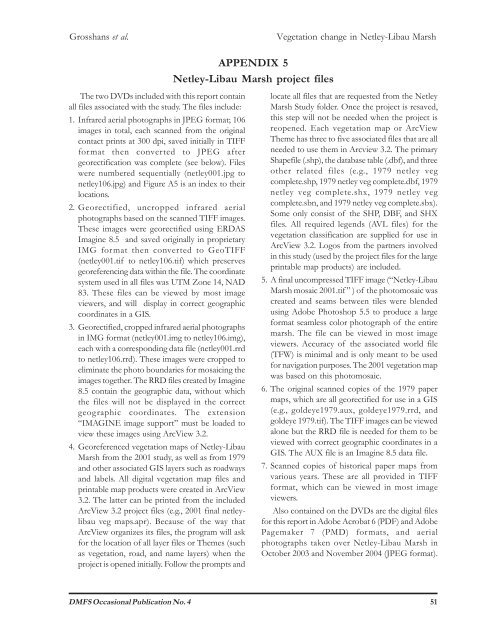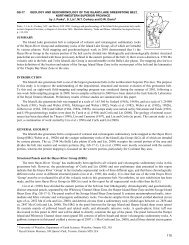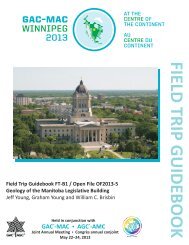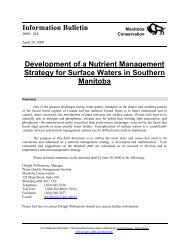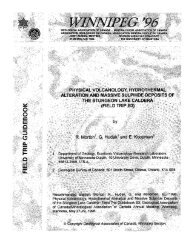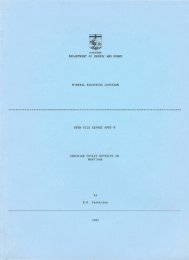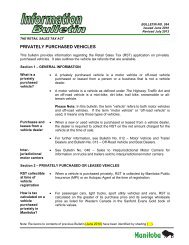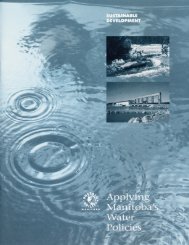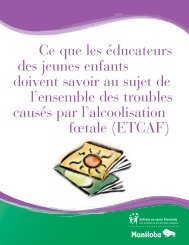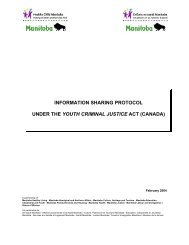Changes in the Emergent Plant Community of Netley-Libau Marsh ...
Changes in the Emergent Plant Community of Netley-Libau Marsh ...
Changes in the Emergent Plant Community of Netley-Libau Marsh ...
Create successful ePaper yourself
Turn your PDF publications into a flip-book with our unique Google optimized e-Paper software.
Grosshans et al.<br />
Vegetation change <strong>in</strong> <strong>Netley</strong>-<strong>Libau</strong> <strong>Marsh</strong><br />
APPENDIX 5<br />
<strong>Netley</strong>-<strong>Libau</strong> <strong>Marsh</strong> project files<br />
The two DVDs <strong>in</strong>cluded with this report conta<strong>in</strong><br />
all files associated with <strong>the</strong> study. The files <strong>in</strong>clude:<br />
1. Infrared aerial photographs <strong>in</strong> JPEG format; 106<br />
images <strong>in</strong> total, each scanned from <strong>the</strong> orig<strong>in</strong>al<br />
contact pr<strong>in</strong>ts at 300 dpi, saved <strong>in</strong>itially <strong>in</strong> TIFF<br />
format <strong>the</strong>n converted to JPEG after<br />
georectification was complete (see below). Files<br />
were numbered sequentially (netley001.jpg to<br />
netley106.jpg) and Figure A5 is an <strong>in</strong>dex to <strong>the</strong>ir<br />
locations.<br />
2. Georectified, uncropped <strong>in</strong>frared aerial<br />
photographs based on <strong>the</strong> scanned TIFF images.<br />
These images were georectified us<strong>in</strong>g ERDAS<br />
Imag<strong>in</strong>e 8.5 and saved orig<strong>in</strong>ally <strong>in</strong> proprietary<br />
IMG format <strong>the</strong>n converted to GeoTIFF<br />
(netley001.tif to netley106.tif) which preserves<br />
georeferenc<strong>in</strong>g data with<strong>in</strong> <strong>the</strong> file. The coord<strong>in</strong>ate<br />
system used <strong>in</strong> all files was UTM Zone 14, NAD<br />
83. These files can be viewed by most image<br />
viewers, and will display <strong>in</strong> correct geographic<br />
coord<strong>in</strong>ates <strong>in</strong> a GIS.<br />
3. Georectified, cropped <strong>in</strong>frared aerial photographs<br />
<strong>in</strong> IMG format (netley001.img to netley106.img),<br />
each with a correspond<strong>in</strong>g data file (netley001.rrd<br />
to netley106.rrd). These images were cropped to<br />
elim<strong>in</strong>ate <strong>the</strong> photo boundaries for mosaic<strong>in</strong>g <strong>the</strong><br />
images toge<strong>the</strong>r. The RRD files created by Imag<strong>in</strong>e<br />
8.5 conta<strong>in</strong> <strong>the</strong> geographic data, without which<br />
<strong>the</strong> files will not be displayed <strong>in</strong> <strong>the</strong> correct<br />
geographic coord<strong>in</strong>ates. The extension<br />
“IMAGINE image support” must be loaded to<br />
view <strong>the</strong>se images us<strong>in</strong>g ArcView 3.2.<br />
4. Georeferenced vegetation maps <strong>of</strong> <strong>Netley</strong>-<strong>Libau</strong><br />
<strong>Marsh</strong> from <strong>the</strong> 2001 study, as well as from 1979<br />
and o<strong>the</strong>r associated GIS layers such as roadways<br />
and labels. All digital vegetation map files and<br />
pr<strong>in</strong>table map products were created <strong>in</strong> ArcView<br />
3.2. The latter can be pr<strong>in</strong>ted from <strong>the</strong> <strong>in</strong>cluded<br />
ArcView 3.2 project files (e.g., 2001 f<strong>in</strong>al netleylibau<br />
veg maps.apr). Because <strong>of</strong> <strong>the</strong> way that<br />
ArcView organizes its files, <strong>the</strong> program will ask<br />
for <strong>the</strong> location <strong>of</strong> all layer files or Themes (such<br />
as vegetation, road, and name layers) when <strong>the</strong><br />
project is opened <strong>in</strong>itially. Follow <strong>the</strong> prompts and<br />
locate all files that are requested from <strong>the</strong> <strong>Netley</strong><br />
<strong>Marsh</strong> Study folder. Once <strong>the</strong> project is resaved,<br />
this step will not be needed when <strong>the</strong> project is<br />
reopened. Each vegetation map or ArcView<br />
Theme has three to five associated files that are all<br />
needed to use <strong>the</strong>m <strong>in</strong> Arcview 3.2. The primary<br />
Shapefile (.shp), <strong>the</strong> database table (.dbf), and three<br />
o<strong>the</strong>r related files (e.g., 1979 netley veg<br />
complete.shp, 1979 netley veg complete.dbf, 1979<br />
netley veg complete.shx, 1979 netley veg<br />
complete.sbn, and 1979 netley veg complete.sbx).<br />
Some only consist <strong>of</strong> <strong>the</strong> SHP, DBF, and SHX<br />
files. All required legends (AVL files) for <strong>the</strong><br />
vegetation classification are supplied for use <strong>in</strong><br />
ArcView 3.2. Logos from <strong>the</strong> partners <strong>in</strong>volved<br />
<strong>in</strong> this study (used by <strong>the</strong> project files for <strong>the</strong> large<br />
pr<strong>in</strong>table map products) are <strong>in</strong>cluded.<br />
5. A f<strong>in</strong>al uncompressed TIFF image (“<strong>Netley</strong>-<strong>Libau</strong><br />
<strong>Marsh</strong> mosaic 2001.tif ” ) <strong>of</strong> <strong>the</strong> photomosaic was<br />
created and seams between tiles were blended<br />
us<strong>in</strong>g Adobe Photoshop 5.5 to produce a large<br />
format seamless color photograph <strong>of</strong> <strong>the</strong> entire<br />
marsh. The file can be viewed <strong>in</strong> most image<br />
viewers. Accuracy <strong>of</strong> <strong>the</strong> associated world file<br />
(TFW) is m<strong>in</strong>imal and is only meant to be used<br />
for navigation purposes. The 2001 vegetation map<br />
was based on this photomosaic.<br />
6. The orig<strong>in</strong>al scanned copies <strong>of</strong> <strong>the</strong> 1979 paper<br />
maps, which are all georectified for use <strong>in</strong> a GIS<br />
(e.g., goldeye1979.aux, goldeye1979.rrd, and<br />
goldeye 1979.tif). The TIFF images can be viewed<br />
alone but <strong>the</strong> RRD file is needed for <strong>the</strong>m to be<br />
viewed with correct geographic coord<strong>in</strong>ates <strong>in</strong> a<br />
GIS. The AUX file is an Imag<strong>in</strong>e 8.5 data file.<br />
7. Scanned copies <strong>of</strong> historical paper maps from<br />
various years. These are all provided <strong>in</strong> TIFF<br />
format, which can be viewed <strong>in</strong> most image<br />
viewers.<br />
Also conta<strong>in</strong>ed on <strong>the</strong> DVDs are <strong>the</strong> digital files<br />
for this report <strong>in</strong> Adobe Acrobat 6 (PDF) and Adobe<br />
Pagemaker 7 (PMD) formats, and aerial<br />
photographs taken over <strong>Netley</strong>-<strong>Libau</strong> <strong>Marsh</strong> <strong>in</strong><br />
October 2003 and November 2004 (JPEG format).<br />
DMFS Occasional Publication No. 4 51


